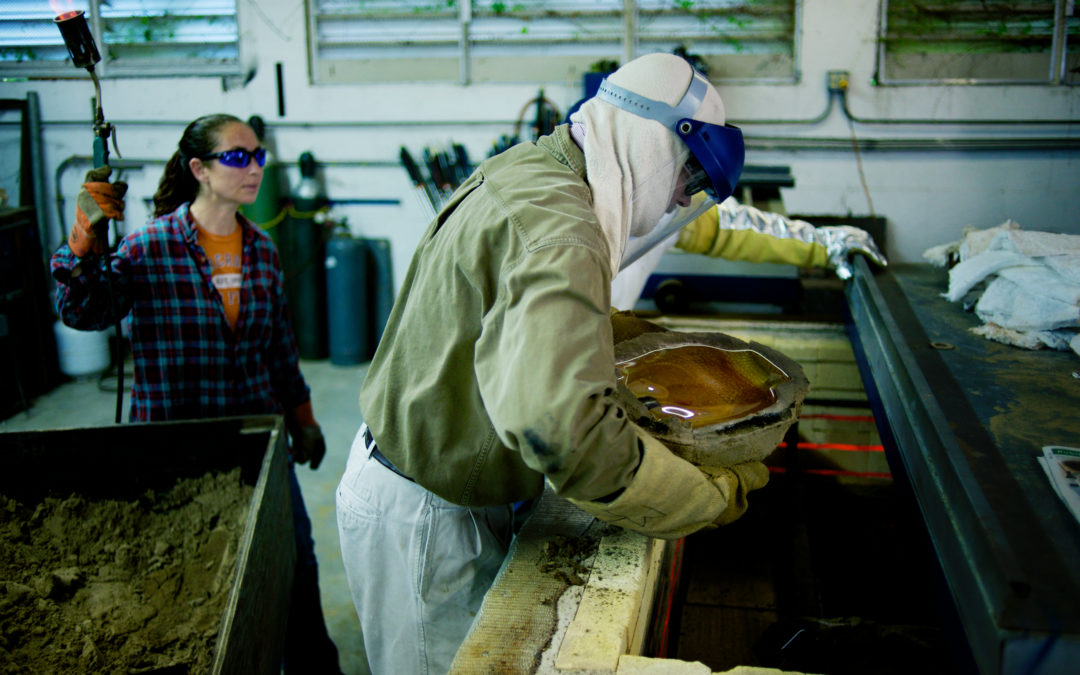We have made the mold, pressed it onto the sand and filled it with liquid molten glass. We are on the journey to a fine art glass sculpture!
Now Comes the Tricky Part…!
As soon as it touches the sand the glass immediately starts to cool. Here we come to the really tricky part, getting the glass to cool evenly so it doesn’t crack.
The glass in the crucible is at 2,000 degrees. Once Thomas has poured it, we have about ten minutes. We need the glass to be at the magic number of 900 degrees, where it is firm enough not to deform when we pick it up… or so cold it will crack.
The top layer of glass cools first, as it is exposed to the air and not insulated by the sand. I use a propane torch, a “mere” 1,200 degrees, to provide a general wash of heat over the top of the glass.
We also have a propane-oxygen torch that reaches 2,400 degrees. This one requires great skill and care, as it can actually boil the glass and ruin the artwork if we are not careful. I use it to heat the thinner parts of a casting, like the edges, which cool quickest. When the piece combines thicker and thinner parts this can become tricky. The thinner parts cool quicker and the thicker parts retain their heat… It becomes a balancing act…
I use my eyes to judge the temperature. We have found this is far more accurate than the fancy laser machine we tried… I guess a couple of decades of doing this has some value!
The Tension Builds…
Will it crack? Deform? Or be just right? Will it be my Horse, a perfect, fine art glass sculpture? Or a shards of a fractured dream?
We sweat some more!
Thomas uses our special shovel (Home Depot, $15.95!) to gently cut away at the sand, cutting deeper near the thickest and hottest parts of the piece so they cool faster, keeping the sand tucked against the thinner parts to slow their cooling. Quite an art. Take away too much sand, and the piece will deform, to much and it cracks… you know the drill! Layer by layer he cuts until there is only a shell of hardened sand around the piece.
Then comes the moment. I give the word and. Some lucky guy (Thomas again!) gets to pick up the glass with heavily gloved hands and carry it over to the closest cooling oven. This oven has been pre-heated to 900 degrees to receive the hot glass. Another assistant slides open the heavy top of the oven and Thomas leans over and into the deeps and places his precious cargo in a carefully pre-determined position. We quickly close the oven to minimize heat loss. And to make sure Thomas does not catch fire!
Becoming Cool
Once the cooling oven (also called an annealer) is loaded with the day’s work we set the computer for a week-long cooling program. Why do we do this? Why the fuss over the cooling of the glass? In casting metal, you can just crack open the mold as soon as the liquid metal has solidified, and although it is very hot, you can manhandle it right away.
Glass is a different animal. As it cools, it shrinks, and of course the outside layers cool first. This puts tremendous stress on the hotter, inner portion, and eventually you hear a dreaded and unmistakable “PING!” sound that tells you the glass has cracked. Very disheartening after all the effort expended on it.
So, what the annealer does is very clever. A little computer built into the oven controls the cooling process, and slowly drops the temperature degree by slow degree until the glass reaches what is called a “stress point”. This is where the glass would normally crack.
Very smart people have figured these stress point temperatures very exactly. The computer holds the temperature of the oven at a point just above where the glass would crack until the whole piece is at the same temperature, and the outer layers are no longer shrunk tight over the inner layers. Typically, this step takes about 24 hours. Then the glass is and ready for its next slow glide down to the next ‘stress point’.
Tricky stuff. You can see how the time just stacks up. And along with it the impatience…!
But no, there is no peeking! To open the oven just for a quick look would allow all the hot air to escape and the heating elements would have to kick in and this would stress the glass even further. Then the dreaded PING…! Ask us how we know this…!
And So We Wait…
We wait for a week. I replay in my mind, endlessly, the whole pouring and putting away process, looking for any moment of indiscretion.
A stray bead of sweat, (strangely, not uncommon in an un-air-conditioned studio with a 2,000-degree crucible in it, in Florida, in summer…!), this stray drop, falling unnoticed into the sand of a mold can cause a bubble of steam to rise through the glass, destroying it.
A glove, at room temperature, is a thousand degrees cooler than the glass, and brushed across a piece of just-cast glass can cause fine cracks that spread and multiply.
There is just one way to do cast glass right. We have made exhaustive exploration of many of the ways to not do this! As Thomas says, we never make the same mistake twice, we just make all-new ones!
A week will pass before we can slide open the oven and crack away the layer of sand still clinging to the glass and see what time and heat and sand has made. Is it fine art glass sculpture?
We wait…


Recent Comments